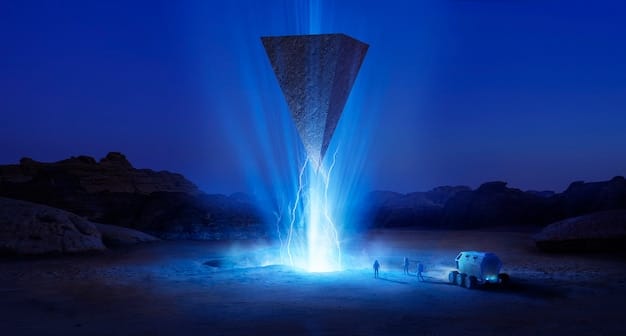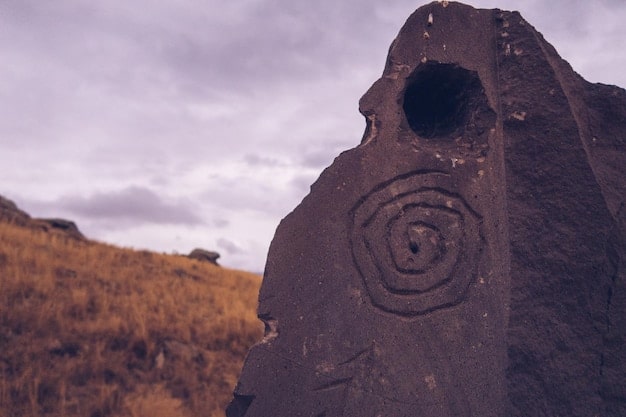The Monoliths’ Purpose: Interdimensional Travel in Game Lore

The Monoliths, recurring structures in various games, often serve as portals or keys to interdimensional travel, influencing gameplay, narrative, and the player’s understanding of interconnected worlds.
The enigmatic presence of the monoliths in video games has sparked curiosity and speculation among players and developers alike. Their imposing structures, often imbued with otherworldly energy, raise a fundamental question: What is their purpose? This article delves into the mysteries surrounding the monoliths’ purpose in game lore, specifically investigating their connection to interdimensional travel and their impact on the gaming experience.
Unraveling the Mystery of the Monoliths
Monoliths, appearing throughout gaming history, spark intrigue: towering structures with unknown origins. They often represent gateways between worlds, challenging players with puzzles and offering deeper narrative insights.
But what exactly do these monoliths symbolize, and how do they influence the intricate tapestries of game lore? Let’s explore.
Symbolism and Significance
Monoliths can represent various themes. One common interpretation is that they symbolize ancient knowledge or technology, left behind by a long-lost civilization. Their presence may hint at a deeper history or a forgotten power, prompting players to unravel the secrets they hold.
In other instances, monoliths embody pivotal turning points in the game’s storyline, requiring players to use all their skills to surpass the game.
- Ancient Knowledge: Monoliths may store secrets from past civilizations.
- Interdimensional Portals: They often serve as gateways between worlds or dimensions.
- Challenges and Puzzles: Monoliths frequently present challenges that players must overcome.
Narrative Impact
The impact of monoliths on game narratives is significant. They are not mere background elements; they intricately weave into a game’s storytelling, adding layers of depth and intrigue. Their introduction often changes the overall goals.
Whether unraveling secrets or activating portals, monoliths can propel the narrative forward in dynamic ways.

The Monoliths as Interdimensional Gateways
A common theme associated with monoliths in the game lore is their role as interdimensional gateways. Many games use these massive structures as pivotal junctures for players to transition between different realms and maps.
The use of monoliths as portals enhances the excitement of traveling to new levels of the game, as well as the anticipation of what lies ahead. Their integration into gameplay is key.
Activation and Operation
Activating monoliths often involves solving complex puzzles. These puzzles may require players to manipulate symbols, align energy beams, or use specific items found throughout the game world. The process can be challenging, requiring both cognitive skills and physical dexterity.
Once properly activated, the monolith typically opens a portal, a shimmering gateway visually representing the journey between dimensions.
- Puzzle Solving: Activation usually requires solving intricate puzzles.
- Item Collection: Players may need to gather specific items to activate the monolith.
- Energy Manipulation: Some monoliths require the manipulation of energy sources.
Consequences of Interdimensional Travel
Traveling through monoliths always has consequences. These impacts can range from minor alterations to world-shifting events. When navigating new dimensions, there are risks and rewards for even the most skilled players.
These impacts can shape the player’s journey through the game.
Exploring Different Dimensions
The dimensions accessed through monoliths vary greatly. Some games offer a stark, jarring contrast between dimensions, changing the environmental conditions and adding new adversaries to the game.
Each dimension has its own set of rules, which impacts the gameplay and rewards system.
Unique Environments
Each dimension introduces distinct visual and environmental elements. These areas may feature surreal landscapes, alien flora and fauna, and unusual atmospheric conditions. The contrast between dimensions can be striking, offering players a sense of wonder and discovery.
Environmental elements are not merely cosmetic; they often play an integral role in gameplay, affecting player movement, combat tactics, and puzzle-solving strategies.
Challenges and Opportunities
Exploring new dimensions presents both challenges and opportunities for players. New enemies, obstacles, and puzzles demand adaptive tactics and skills. Additionally, unique resources, items, and abilities can be found, enhancing the player’s capabilities.
These rewards encourage exploration and add depth to the gameplay. It is up to the player to adapt to his or her environment.
The Monoliths and the Game’s Central Theme
The integration of monoliths often aligns with the overarching theme of a game. Their presence often underscores the core concept of the game, while providing meaningful challenges.
Understanding how monoliths relate to a game’s core narrative can greatly enrich the player’s comprehension and appreciation.

Reflecting Core Concepts
Monoliths frequently mirror the fundamental themes of the game. If a title focuses on exploration, the monoliths may serve as pivotal gateways to uncharted territories. In narratives centered around conflict, they could represent strategic strongholds or control points.
In instances where a game explores mystical or spiritual themes, monoliths may act as conduits to higher planes of existence or sources of divine power.
Driving the Narrative Forward
Strategically deployed monoliths can significantly enhance a game’s narrative momentum. They act as catalysts, propelling the story forward and providing players with clear objectives.
By gating progression through monolith-related challenges, game developers ensure that players remain engaged with the storyline while also actively participating in the game world.
The Player’s Role and Experience Interdimensional Travel
The extent of player engagement with monoliths varies across different games. In some, completing games relies on mastering all levels and challenges related to monoliths.
Understanding the level of engagement is not only critical to the progression of a game, but also the overall gaming experience the player has.
Interactive Elements
The interactive elements linked to activation of monoliths shape the player’s experience. These can encompass everything from intricate puzzle-solving to resource collection. Challenges must be stimulating but not overly challenging
The gameplay is rewarding because completing tasks provides a sense of accomplishment and increases motivation.
- Exploration: Exploring different areas or items in the game offers deeper insights.
- Resource Management: Gathering required resources or completing challenging levels in a game is important.
Shaping Player Perception
Exploring gameplay is always interesting to the player as new challenges and items become more rewarding to collect. The sense of discovery, exploration and challenge is a key part of the gaming experience.
Players find a game rewarding when they can engage and have a sense of progression and challenge combined.
Future Trends in Monolith Design
The future of monolith design in video games is bright, with emerging technologies and innovative design approaches set to elevate their role and impact. These enhancements may offer new gaming experiences.
Considering these advances, the future of monolith usage may be very dynamic.
Enhanced Realism and Immersion
Future titles should incorporate enhanced realism and more immersion for players. Realistic graphics make gameplay more lifelike and challenging, which enhances the gaming experience.
The industry’s adoption of realistic features and engaging stories has the potential to propel it forward.
Dynamic Narrative Integration
Looking ahead, there will likely be growing emphasis on dynamic integration of monoliths into storylines. Monoliths will be designed to change in response to player actions and decisions, and the storyline will become complex.
As more games incorporate dynamic elements, these features may provide new challenges to gameplay.
| Key Point | Brief Description |
|---|---|
| 💡 Symbolism | Represent ancient knowledge or gateways. |
| 🔑 Activation | Requires puzzle-solving or item collection. |
| 🌌 Dimensions | Offer unique environments and challenges. |
| 🎮 Player Role | Engage through exploration and resource management. |
Frequently Asked Questions
▼
Monoliths often symbolize ancient knowledge, forgotten technologies, or gateways to other dimensions in the game’s lore.
▼
Activation typically involves solving intricate puzzles, collecting specific items, or manipulating energy sources within the game.
▼
Monoliths can open pathways to diverse environments that challenge gameplay.
▼
Monoliths serve as catalysts, giving new objectives to players.
▼
Exploration is very important as players are introduced to diverse parts of a story.
Conclusion
In conclusion, the monoliths in games are not merely static structures but dynamic elements that enrich gameplay. They serve as portals to new dimensions, test and reward players, and are frequently associated with the central theme of the game.





